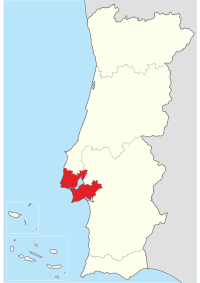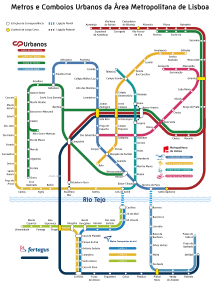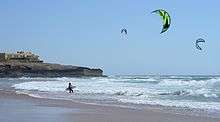Lisbon Region
The Lisbon Region is the region surrounding Lisbon, the capital of Portugal. It consists of municipalities located on both banks of the wide mouth of the Tagus (Tejo) river where it meets the Atlantic Ocean. The region includes a variety of localities—from historic towns and cities, to ports, industrial areas, beach resorts, and natural reserves. It offers a varied mixture of holiday opportunities to visitors, as they can engage in beach activities, various active sports, and do a fair share of sightseeing.

Portugal has a multi-layered and complicated system of administrative divisions that is not always useful for visitors. Therefore, for this guide, the definition of the Lisbon Region used by the European Union NUTS system is used, which covers most of the territories of Portugal's traditional districts of Lisbon (north of Tagus) and Setubal (south of Tagus).
Cities
- 🌍 Lisbon – the country's capital and central city of the Region
- 🌍 Almada – facing Lisbon over the river Tagus, with an imposing hilltop statue of Cristo Rei
- 🌍 Cabo da Roca – Europe's westernmost point
- 🌍 Cascais – one of Europe's oldest holiday resorts with as much sunshine as heritage
- 🌍 Ericeira
- 🌍 Mafra
- 🌍 Massamá
- 🌍 Paço de Arcos
- Praia das Maçãs
- 🌍 Queluz
- 🌍 Seixal – a city near the Tagus River
- 🌍 Setúbal – a busy port and a lesser-known resort
- 🌍 Sintra – famous for a number of palaces spread over its green hills
Other destinations
- 🌍 Natural Park of Arrábida
Understand
Talk
The language spoken in the Lisbon Region is Portuguese, the same as the Portuguese spoken anywhere else in Portugal, but quite different from the Portuguese spoken in Brazil.
Spanish is widely understood, if not spoken. Most younger people and those working in the tourism industry speak English as well.
Get in
By plane
There are two airports within the Lisbon Region: Lisbon Portela Airport, which handles scheduled and charter passenger flights, and Aeródromo Municipal de Cascais, which is a small airport for general aviation (private planes) in Cascais.
One alternative is to fly to the Francisco Sa Carneiro airport in Porto and then take the Porto Metro to the Campanha station and further take a long-distance train to Lisbon from there. The train alone takes 3 hours in each direction, but you can take advantage of the oftentimes cheaper connections to the Porto airport and include Porto in your trip this way.
By train
In general, long-distance trains calling in the Lisbon Region will stop in Lisbon only. There are trains from the north and south of Portugal, as well as international trains from Spain calling there. You will probably need to change stations from where your long-distance train arrives to your bus or train connection to your destination outside of Lisbon - please refer to our guide to Lisbon for more detailed information.

Get around
There is an efficient, if a bit complicated, transportation system within the Lisbon Region. At its backbone are the local railways, supported by the light rail systems and the ferries across the Tagus, complimented by bus connections, all of which have several operators.
The railway system consists of four separate suburban railway lines managed by the state-owned Portuguese railway operator, under the name of Serviços Urbanos da CP. The four lines start from different stations around Lisbon and connect to different destinations:
- the Cascais line (yellow) starts at Cais do Sodre station in Lisbon and goes to Cascais, Estoril and Oeiras.
- the Sintra line (green) has stops at Rossio in the historic centre of Lisbon and terminates in Sintra, with locations in the hills northwest of Lisbon, such as Amadora, on its way. Some trains on the green line go as far as the Oriente station in Lisbon, which is close to the Lisbon Airport
- the Azambuja line (red) starts at Santa Apolonia station and goes through Oriente in Lisbon, taking you northeast along the Tagus to Azambuja and all the municipalities along the way, which are of minor touristic interest
- the Sado line (blue) is not named after perversely pleasurable acts of violence, but rather the estuary of the Sado River, which the line serves. The line starts in Barreiros on the south bank of the Tagus, where you can get by a ferry from the very heart of Lisbon. Various municipalities are on the line's route, including Setubal.
In addition to the normal course of those lines, the red and green line also have trains traversing the railway arc through the north of Lisbon, which includes the Campolide, Sete Rios, Entrecampos and Oriente stations.
The only railway line crossing the Tagus, by means of the Bridge of April 25 in Lisbon, is operated by an entirely separate company called Fertagus, using navy in its corporate identity and commonly identified as such in schematic maps. The Fertagus trains start at Setubal and take a wide arch through the Setubal peninsula, while on the north side of Tagus they follow the abovementioned railway arc of Campolide, Sete Rios and Entrecampos stations, not going to Oriente though.
Complementing and binding together those railway connections are the underground rail systems - the Lisbon Metro, which connects the various Lisbon railway stations (as do the buses and trams operated by Carris, Lisbon's municipal transit company) and the Metro de Sul tramway system in Almada and surrounding municipalities. To close the gap the Tagus poses, a company called Transtejo operates a number of regular ferry connections between various quays in Lisbon and municipalities on the southern side of the river.
See
There is an obvious wealth of historic monuments, museums, galleries and other attractions in the grand old city of Lisbon, which is probably where more tourists will start their visit anyway. Do not miss the UNESCO World Heritage site of Sintra, with numerous royal palaces of fairytale qualities scattered across the lush green hills and magnificent gardens. Head for the beaches of Cascais and Estoril to experience the Atlantic Ocean and some high life of the famous resorts.
Across the Tagus, visit Almada for the magnificent views from the statue of Cristo Rei towering over Lisbon and the region. For a glimpse into the workings of the port and fishing industries that propel the region, visit Setubal and Sesimbra, which also offer a number of more relaxed beaches than those north of the Tagus.
Itineraries
- Go from Rossio Station in Lisbon to Sintra by train
- Buy the rover ticket for the Greyhound bus that lets you travel in and beyond Sintra (there is a cheaper one for Sintra only)
- Use the local bus to see the town and the National Palace, the Castelo dos Mouros and the extraordinary Pena Palace.
- Take a bus from the station at Sintra to Cabo da Roca, the westernmost point of mainland Europe
- Take a bus to Cascais (and very possibly eat there)
- Return by train to the Cais do Sodre station in Lisbon.
You will need to check bus timetables carefully but both train lines are frequent and cheap. if you return from Cascais after dark (avoid the late-night train, for safety reasons), you will get wonderful views in Belem of the floodlit buildings.
- South of the River
- Ferry from Lisbon to Montijo
- Bus to Setubal
- Bus to Sesimbra
- Local bus or walk to fishing port (and return)
- Bus to Cacilhas, Almada.
- Ferry to Lisbon

Do
Given the natural conditions, it is obvious that the Lisbon Region is a great place to practice many sports activities, especially those related to the seaside.
Eat
The Portuguese cuisine is both simple and extremely rich, and there is quite a lot to enjoy year-round. That said, being at one of the largest ports of the Atlantic Ocean, you absolutely need to make sure you experience the fresh fish and other seafood, which come in ample supply.
Drink
The Portuguese way of life and typical organisation of the day places a big emphasis on the nightlife, so you will never be out of opportunities to enjoy yourself in the evenings (and oftentimes also well into the night - or morning!) Lisbon is obviously bustling with those, but it does not mean you will not find bustling nightlife in other towns as well.
Stay safe
The region is for the most part safe. Take common precautions, especially in Lisbon's public transportation. Cais do Sodre station should be avoided late at night as well some parts of Bairro Alto nightclubs. Also avoid dark alleys.